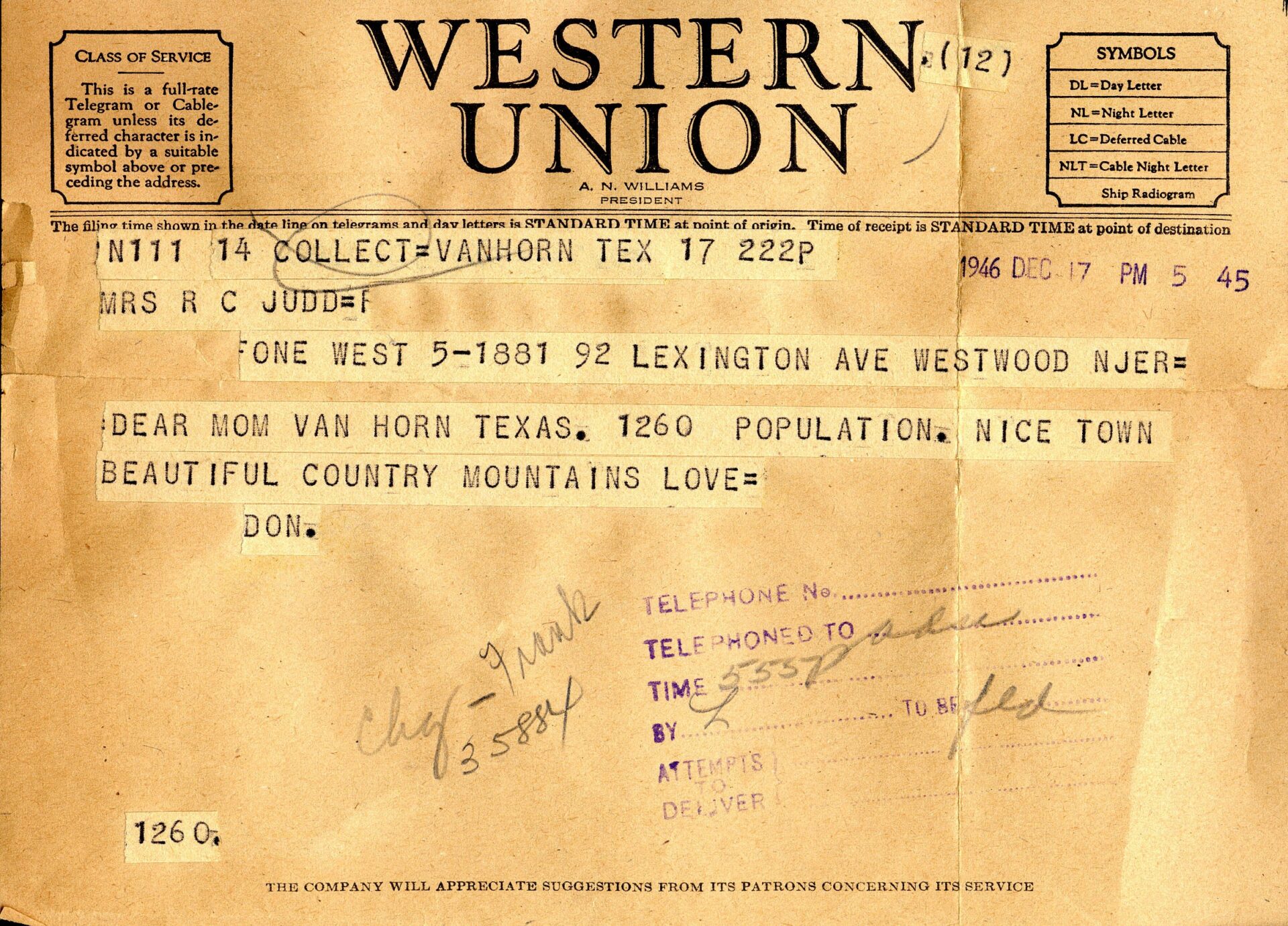

Judd Foundation is pleased to present Local History, featuring findings from the Judd Foundation Archives. In this series, the Foundation will share visual and textual documentation of Donald Judd’s life and work contained within the Archives as a tool to understand the diverse range of his thinking. Selected to open Local History is a 1946 telegram which marks Judd’s first encounter with West Texas, a region that would become central to his life’s work. As Judd wrote in his 1985 essay “Marfa, Texas”:
In late 1946 I and four other soldiers went by bus from Fort McClellan, Alabama, to Los Angeles, where we inveigled a ride from the Army Air Force to San Francisco in order to be shipped to Korea to pester the world. This was the first time that I saw the Southwest, unfortunately according to the days and nights of the bus. Since everyone knows that nothing is accidental and that everything is fully planned, it’s not surprising that I sent a telegram saying: DEAR MOM VAN HORN TEXAS. 1260 POPULATION. NICE TOWN BEAUTIFUL COUNTRY MOUNTAINS – LOVE DON 1946 DEC 17 PM 5 45.

Western Union Telegram from Donald Judd to his Mother, 1946 © Judd Foundation.
Enlisting in the United States Army on June 28, 1946, Judd served as a construction foreman in the Army Corps of Engineers. As Judd stated in an unpublished interview from 1968, “We were attached to Kimpo Air Base, the main air base near Seoul. So it [my work in the Army] involved building a number of useful things. And it was interesting and pleasant.” Honorably discharged from the Army after his required military service was complete in November 1947, Judd enrolled in the College of William and Mary, which he attended for less than a year. In the early 1950s Judd attended both the Art Students League where he studied painting, and Columbia University, from which he graduated with a Bachelor of Science in Philosophy. Judd participated in several small exhibitions of his paintings in the early to mid-1950s, most notably at Panoras Gallery where he had his first solo exhibition in the summer of 1957. The reviewer of this show in Arts Magazine described the work as “strong non-objective shapes painted with bald simplicity on a flat-plane background, usually grey.” Paintings from this time-period can be seen by guided visit at Judd Foundation’s Cobb House property in Marfa, Texas, where Judd permanently installed this body of work.
In the late 1950s, Judd enrolled in the graduate art history program at Columbia University where he studied with Rudolph Wittkower and Meyer Schapiro. By the end of the 1950s he had moved into a loft space on 19th street and began writing for Arts magazine as an exhibition reviewer. Now creating works in relief, a major departure from his earlier paintings, by 1962 he transitioned to making and exhibiting work in three-dimensions that he placed directly on the floor. First making these first works in three-dimension by hand, Judd shifted to working with specialized fabricators in 1964. Over the next few years his work was exhibited widely, and included in the eighth Sao Paolo Biennial in 1965 and in the Jewish Museum’s Primary Structures show of 1966, as well as exhibited at Leo Castelli’s gallery on East 77th Street. In 1968 Judd purchased 101 Spring Street, a five-story cast-iron building built in 1870. This became his primary residence where he lived with his wife and children. 101 Spring Street, which is available for viewing by guided visit, was the first place where Judd installed his work and the work of other artists permanently.
Preferring the landscape and solitude of Baja California, Mexico, and the Southwest United States to life in New York City, Judd began to travel around Mexico, Arizona, and New Mexico, developing architectural projects that engaged the particularities of the desert landscape. It is at this point in the early 1970s when Judd traveled through West Texas, again passing through Van Horn, but this time on the way to Marfa, where he rented a small house in town. By 1974, Judd purchased what remained of a former Army compound between Marfa’s main highway and the Southern Pacific Railroad Track, referring to this space as both The Block, because the property takes up a whole city block, and La Mansana de Chinati, in reference to the Chinati Mountains south of Marfa. Judd spent a significant portion of the next twenty years of his life in Marfa, Texas, stating in a 1990 interview, “The work is in Texas because I live there, this is an accident. It is not a choice to be remote, but the fact is that you can’t do anything very large and serious in the middle of society.”